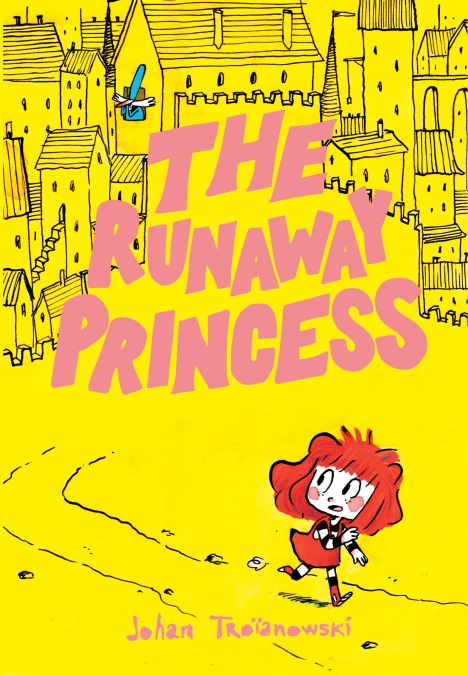

Kids were largely responsible for the popularization of comic books when they first debuted, and after decades of the comics community trying to break the prejudice that these books are juvenile entertainment, kids are once again responsible for driving sales while taking the medium to new heights of respectability. The impact of graphic novels was on full display at this Monday’s 2020 Youth Media Awards, where eight graphic novels were honored. The big news of the event was Jerry Craft’s New Kid making history as the first graphic novel to win the John Newbery Medal, one of the most prestigious awards in children’s literature. It’s fitting that a graphic novel would earn a Newbery Medal after a decade that saw the medium dramatically expand in the kids and YA book markets; the industry recognizes how graphic novels are driving readership and celebrates the efforts of these creators.
Penguin Random House is the world’s biggest publishing house, so it was a huge deal when it announced it would be launching a dedicated graphic novel imprint spearheaded by Gina Gagliano, former associate director of publicity and marketing at First Second. (Full disclosure: I worked with Gagliano very closely while she was at First Second.) Gagliano shares her expertise with the world as the co-host of the Graphic Novel TK podcast with Alison Wilgus, and RH Graphic benefits from Gagliano in the driver’s seat. The debut line-up puts the imprint in a very good place with a mix of early reader, middle-grade, and YA offerings. (Check out previews of each launch title here.) And if a logo indicated an imprint’s future, I would bank on RH Graphic because designer Patrick Crotty delivers perfection. He brilliantly reinvents Random House iconography with simple geometric shapes that come together to say something profound about the publisher’s identity. The Random House Children’s Books logo is a whimsical reimagining of the main Random House logo, and RH Graphic simplifies the visual even further so that it can be composed from the shape of two books laid on top of each other.
Johan Troïanowski’s The Runaway Princess is the first RH Graphic book to hit stands, arriving in a compact, easily portable package with a bright yellow cover that promises a sunny, warm read. Originally published in France as three separate volumes between 2015 and 2017, The Runaway Princess features a trio of stories taking Princess Robin and a quartet of younger brothers to fantastic locales. Everything about The Runaway Princess’ aesthetic is pleasant and playful; after the title appears on the first page, it repeats again but the word “Princess” is in the midst of running away. Each story begins with a two-page map detailing the landscape of that specific adventure, providing a teaser of what’s to come and stimulating the reader’s imagination before the action begins.
The most popular graphic novels in the U.S. right now are Dav Pilkey’s Dog Man titles—the most recent installment, Fetch-22, had a first printing of five million copies—and a key component of the series’ success is its crude art style, evoking the spontaneity and enthusiasm of a child’s drawings. Troïanowski’s artwork in The Runaway Princess is significantly sharper than Pilkey’s, but it still has a looseness that reads as childish in the best way. The artwork is bursting with color, using a combination of ink washes and crayons to give the coloring depth and texture that enriches its vibrancy.
One of my favorite moments in The Runaway Princess is a small two-panel sequence that shows the queen jumping off of the castle tower to go find her daughter, presented with a deadpan nonchalance that feels very parental. There’s no real panic when the queen realizes Robin has run away, and her body language as she floats through the air exudes an air of “ehn, whatever” as she goes to pick up her daughter from whatever misadventure she’s gotten herself into. By giving the queen the literal ability to fly, Troïanowski strengthens the metaphor of Princess Robin as a baby bird leaving the nest, venturing off until she needs one of her parents to lead her back home.
The Runaway Princess opens with a standard setup as it shows a princess running from her royal duties to have some unsupervised fun, but there are early twists in the execution that put a more inventive spin on the storytelling. As Robin enters The Ogre’s Forest, the growing thicket of dark, skeletal trees transforms into a monstrous being threatening to chomp down on the princess with its wooden teeth. It’s a powerful way to indicate the dangers of this environment, using more surreal, representative imagery that taps into a primal fear of the darkness and the predators that can hide within. On the very next page, Troïanowski introduces the reader interaction that truly sets The Runaway Princess apart, asking you to close the book and shake it three times to help Robin escape from a wolf. Open the book again and turn the page to discover that the trees have all been knocked down, taking out the wolf and giving Robin the opening to keep running.
There are two different kinds of interactive elements in The Runaway Princess: traditional puzzle activities like mazes and connect-the-dots, and story moments that ask the reader to perform a specific action that more aggressively impacts the events on the page. Yell out a character’s name to pull them out of a spell. Turn the book to the left and change the direction of gravity to save the gang from a witch and her pumpkin henchmen. This kind of interactivity is common in picture books for younger readers, but it disappears when images are eventually replaced by prose. The Runaway Princess exuberantly embraces the sense of play that can fall away from the reading experience as kids get older, taking advantage of the medium’s visual components to make the reader an active participant in Robin’s journeys.

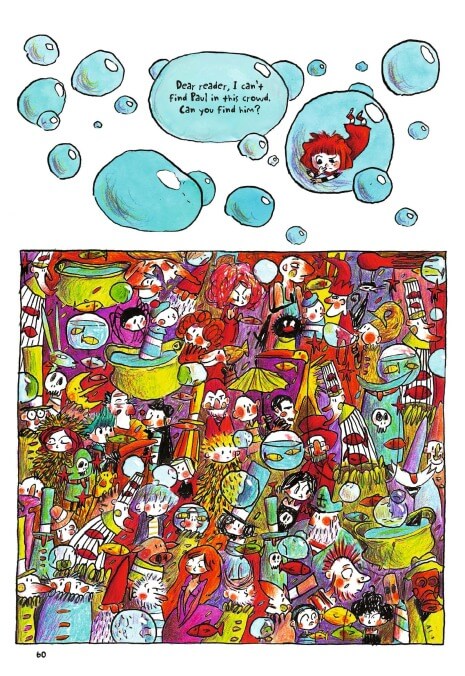

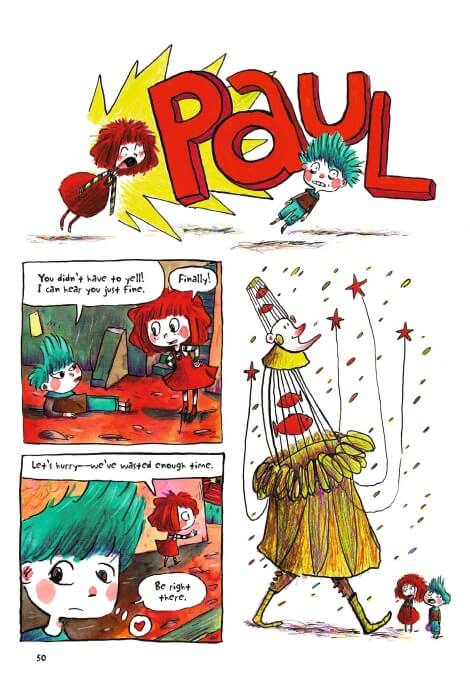

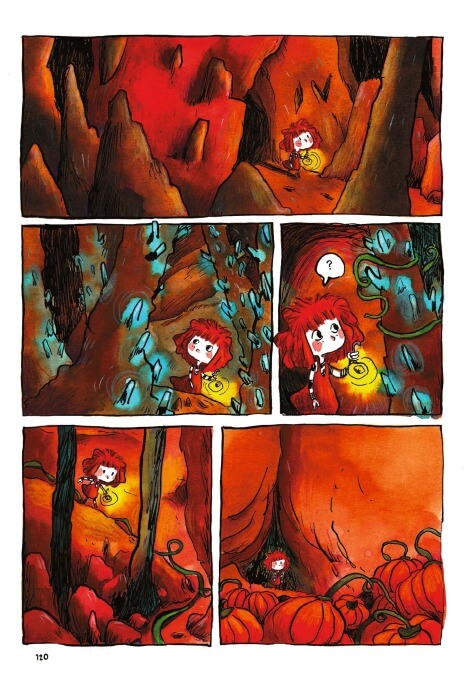
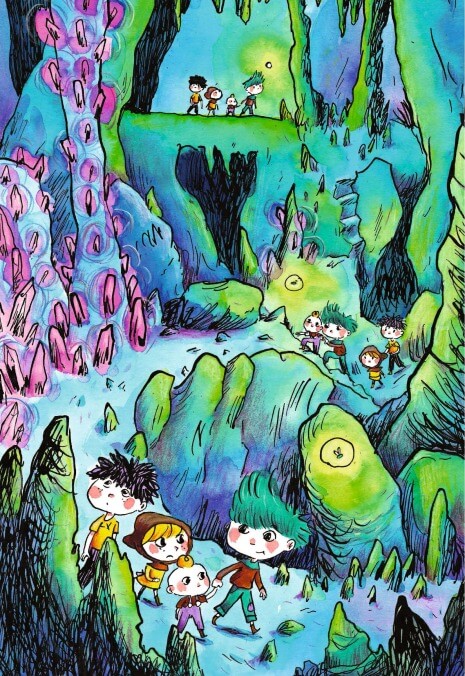
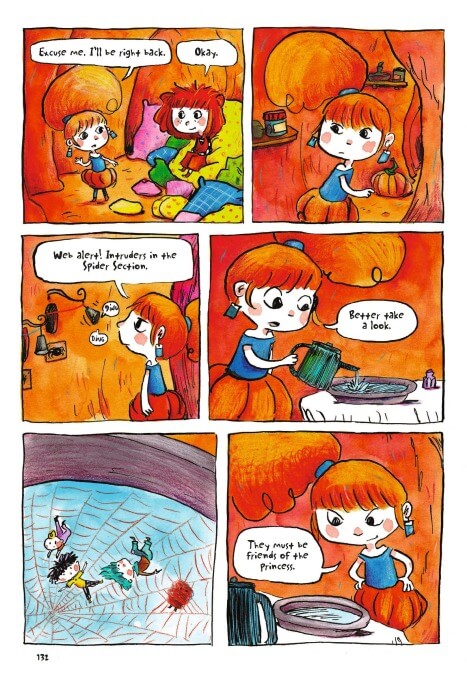
1 Comment
This looks so much better than the preview pages. It’s super imaginative in a way more books in any genre could be. Why should children’s books be the only one’s influenced by Dr. Seuss’ sense of surrealism? The only recent books I can think of that takes advantage is Prism Stalker and ODY-C.